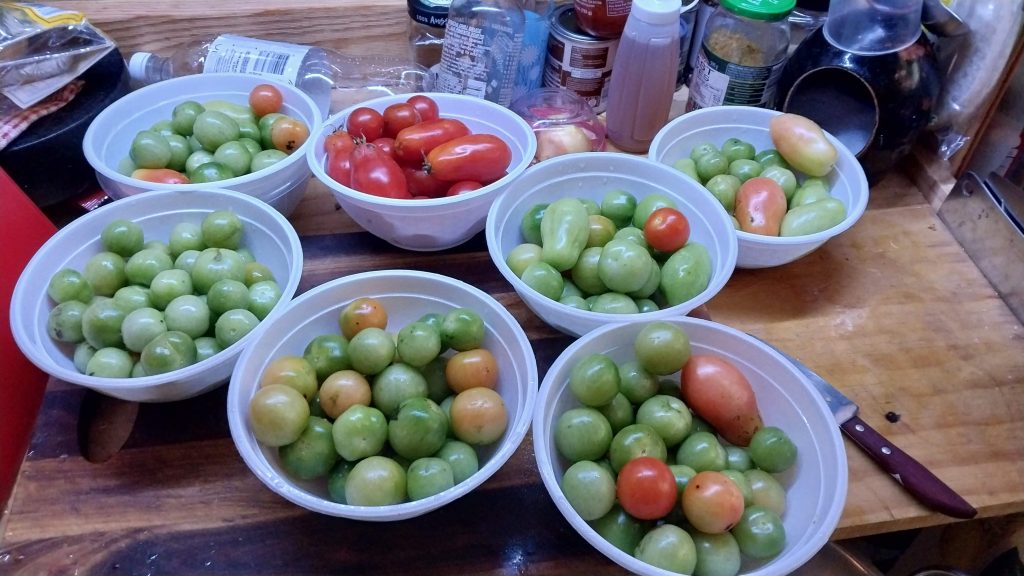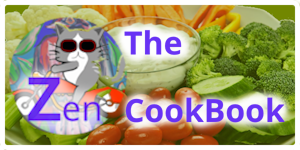That grump is that we’ve been eating for three hundred thousand years (as Homo sapiens) and around 5 million as pre-Hs hominids – and we still don’t understand – food . . .
Oh – I’m not saying our ancestors starved. No- they were incredibly clever about finding food, managing food, and eventually farming food. But understand it? We have laboratories and research facilities and we still don’t know – if you’ll pardon my scatological comparison – shit about what we eat, when you break it down.
You may think I’m splitting hairs in this article, but I hope to prove to you that what you thought you knew about what we know about our “daily bread” is actually lacking. We know about chemicals and compounds but all our knowledge combined only skims the very surface.
I was an old and cynical foodie before I ever learned how energy from our food gets to cells via ATP. (Use the dropdown for a bit more info on this process.)
ATP acts as the primary energy carrier in cells. When we consume food, our bodies break it down through processes like glycolysis, the citric acid cycle, and oxidative phosphorylation. (Sorry – I can’t add a dropdown within a dropdown, but you can duckduckgo it if you like. ) During these processes, energy is released and used to convert ADP (adenosine diphosphate) and inorganic phosphate into ATP.
When cells need energy for various functions, ATP is broken down into ADP and phosphate, releasing that energy that can be used for activities such as muscle contraction, active transport across cell membranes, and chemical synthesis.
And I thought I knew such a lot about food and nutrition… Turns out I was maybe a cook but definitely no dietitian or nutrition specialist. But I’ll give it a go . . .

Thoughts On Food And Humanity
Pre-homo sapiens hominids
They only had direct observation to rely on – this killed Thag when he ate it, this made me sick when I ate it, this stopped me from feeling hungry but I felt weak, this was good because I had the strength to run for half a day or more.
Later, they discovered that foods cooked in / on the fire seemed to have fewer bad consequences, and satisfied hunger more, the energy lasted longer. (That was because cooking certain foods increases the bio-availabliity of nutrients or unlocks certain other nutrients better that our digestive systems.)
Now we have biology
Nowadays, we know more. We know that our bodies are 98% our own so-called “somatic” cells, i.e. cells that compose our actual body, and 2% foreign cells, mostly in our gut, and called “the gut biome.” That few kilos of gut biome and a few other non-local microbes, however, make up more than half the number of cells in our bodies.
So there are more of those in our bodies than the cells that make up our bodies, and they have a correspondingly large effect on our health and energy levels. Also, because there’s a direct connection between the brain and the digestive system via it’s own nerve trunk, the vagus nerve, that lightweight little cluster of billions of bacteria in our guts has a direct connection to the brain.
Our gut biome affects the brain. Our food affects the gut biome. And our location on the planet also affects our gut biome. So quite literally, “you are what you eat” and if you move away from where you live, you may very well be excused for being “homesick” while your gut biome adjusts to the local biome.
When you eat a vegetable or fruit or cereal, you’re also ingesting the microbes in them. Some will take hold and flourish, some will kill of some other microbe species in your gut, and so forth. On top of that, there are also trace elements, minerals, amino acids, vitamins, and other micronutrients in everything you eat.
Some of those will promote some species in your gut biome and hinder or even extinct some species. Since there are many tens of thousands of species in gut biomes, we don’t even know most of them or what they do.
And yet efforts are made to bio-engineer artificial meat from cultured meat cells. The meat in an animal has trace elements created by their gut biome, that a slurry of meat cells in a tank will not get. There amino acids produced by the animal’s organs that won’t be in the grown meat. The microbes in your gut that are fed by those micronutrients in a real beef steak will be starved and may die out completely on lab-grown meat.
The same goes for vegetables -those grown in good healthy soil will have all the micronutrients required for local people’s gut biomes. Vegetables grown in soils where pesticides and herbicides have killed off many of the micro-organisms that healthy soil has, won’t have all those micronutrients. Worse still the plants grown hydroponically.
And if a person at the equator eats a diet of vegetables grown in more polar latitudes, they are getting the wrong micronutrients. The person in higher latitudes that regularly eats tropical fruit isn’t getting the right micronutrients.
And because supermarkets have vegetables from all over the planet and meat from all over the planet, that’s affecting everyone by messing up gut biomes. But gut biomes today are terrible compared to even two hundred years ago. (The drop-down list generated by ChatGPT and edited by me. It’s a longish read but to the best of my knowledge fairly much represents the historical changes.)
The human gut microbiome has evolved significantly over time, influenced by diet, environment, lifestyle, and medical advancements. Here’s a look at how it has changed historically:
1. Hunter-Gatherer Diets (Pre-Agriculture):
- Diverse microbiomes: Early humans who practiced hunting and foraging had diets rich in plants, fiber, and animal products. These diets were highly varied depending on geographic location, leading to diverse gut microbiomes.
- More fiber-digesting bacteria: Their microbiomes were dominated by bacteria capable of breaking down plant fibers, such as species from the genera Bacteroides and Prevotella.
- Seasonal variation: Their microbiomes likely fluctuated with seasonal food availability (meat-heavy diets in winter, plant-heavy in summer).
2. Agricultural Revolution (~10,000 years ago):
- Less diversity: With the shift to farming, the human diet became more grain-based and less varied. This led to a reduction in the diversity of gut bacteria.
- Increased reliance on starch-digesting bacteria: As grains, legumes, and tubers became staples, the gut microbiome adapted, favoring bacteria capable of fermenting starches. This was a shift away from fiber-digesting bacteria.
- Domesticated animals: The rise of farming also brought humans into closer contact with domesticated animals, potentially altering their gut microbiota through zoonotic (animal-borne) microbial exchange.
3. Industrial Revolution (~18th–19th Century):
- Further decrease in diversity: The rise of processed foods, refined sugars, and reduced fiber intake caused a decline in microbiome diversity. Highly processed diets changed gut bacteria composition.
- Impact of urbanization: As people moved into cities, exposure to soil and nature decreased, reducing exposure to environmental microbes that once played a key role in shaping the gut microbiome.
- Increased antibiotic use: With advances in medicine, antibiotics began to be widely used. While lifesaving, antibiotics can wipe out both harmful and beneficial bacteria in the gut, often leading to long-term changes in the microbiome.
4. Modern Times (20th Century – Present):
- Western diets: Today’s modern Western diet is characterized by high consumption of processed foods, low fiber, high sugar, and fats, which has led to an increase in inflammation-associated gut bacteria and a further loss of microbiome diversity.
- Rise in chronic diseases: The modern microbiome is linked to increased rates of obesity, diabetes, inflammatory bowel diseases (IBD), and autoimmune conditions due to shifts in microbial composition.
- Hygiene and sanitation: Improved hygiene practices, while important for public health, have reduced microbial exposures from the environment and other people. This reduction is thought to contribute to conditions like allergies and asthma through the “hygiene hypothesis.” TED: I think this is a bit of an unproven hypothesis and it’s more likely that there not being much natural environment to inoculate our systems is the cause.
- C-sections and formula feeding: More babies born via C-section or fed formula, rather than through vaginal birth and breastfeeding, have different microbiomes. C-sections deprive babies of exposure to maternal vaginal microbes, while formula feeding lacks the microbiota-promoting properties of breast milk. Hygiene and sanitation: Improved hygiene practices, while important for public health, have reduced microbial exposures from the environment and other people. This reduction is thought to contribute to conditions like allergies and asthma through the “hygiene hypothesis.” TED: there is a definite lack of colostrum with what was almost a cultural aversion tobreast feeding but this trend seems to be reversing.
5. Comparison to Traditional Communities:
- Studies comparing modern urban populations with traditional hunter-gatherer or rural farming communities (e.g., the Hadza in Tanzania or Yanomami in the Amazon) show that traditional societies tend to have more diverse and resilient microbiomes.
- Traditional microbiomes are richer in bacteria associated with high-fiber diets and are less affected by antibiotics and processed foods. These communities also show lower rates of chronic inflammatory diseases.
6. Future Trends:
TED: I tend to think the first won’t happen because there’s little profit in it, the second relies on a continuing source of more primal bacteria, and the third is more likely to exacerbate the situation than alleviate it.
- Personalized nutrition and probiotics: As science advances, people are looking at ways to restore microbiome diversity through probiotics, prebiotics, and personalized diets.
- Fecal transplants: This medical procedure, where a healthy person’s stool is transplanted into a patient, is being used to treat certain infections and conditions that arise from disrupted gut microbiomes.
- Urbanization and global changes: Continued urbanization and shifts in global dietary patterns will likely continue to affect the human gut microbiome, though efforts to counter these changes may improve diversity in some populations.
In sum, the gut microbiome has shifted from a diverse, fiber-rich ecosystem to one that is more specialized and less diverse, largely influenced by agricultural practices, urbanization, and the modern diet. This loss in diversity is associated with a rise in certain chronic diseases and may have important implications for human health.
Yeah, that drop-down was a long read. But now I want to introduce a new thought in the form of this paper – the gut biome affects your state of mind. With our gut – brain communications affected as I mentioned just before, is it any wonder people are less caring and more self-absorbed now? Bear in mind that if someone secretly feeds you a rage-inducing psychosis-inducing drug and you kill someone, you’re these days likely to get off the charge of murder and your poisoner be charged for that,
Who reallybears the blame for the state of people and whom does it benefit?
Think about this next time you go shopping…
Like what I write here? Help me! Share my articles. I’ve provided share icons below, and if they aren’t your social scene hit the [+] one at the end and get dozens more. Like my articles to show me which ones I should do more of, and use the “Discover more from The TEdASPHERE Globe” box to subscribe to the newsletter. YOU get to decide what topics interest you and how far apart you’d like the newsletters – make your own personalised version! Lastly, there are KoFi and Paypal links here and also at the bottom of every page, please – I’m not here starting a $1200 GoFundMe or something just as crazy because I can’t make rent, I’m asking for a five or ten spot, and it all goes into defraying costs for this site and updating the facilities on it. Thank you!
Discover more from The TEdASPHERE Globe
Subscribe to get the latest posts sent to your email.



